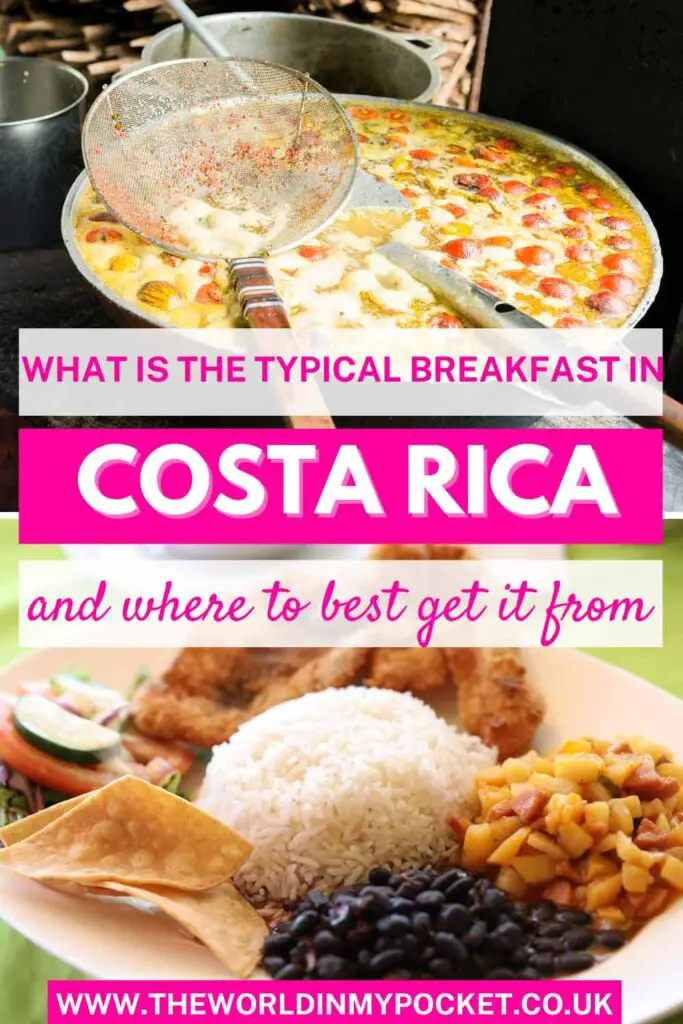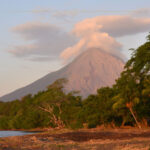Wondering what a typical breakfast in Costa Rica looks like in Costa Rica? You’re in the right place.
A typical breakfast in Costa Rica consists of protein, energy-fueling carbs, healthy fats and fresh tropical fruits. Often paired with Costa Rican brewed coffee, it makes for a great start to the day. There are dishes designed to be savoured leisurely while sipping coffee, as well as popular grab-and-go breakfast options for when you have a busy day full of adventure in Costa Rica.
Costa Rican breakfasts come from foods inspired by a mix of Spanish, Caribbean and Latin American influences. The breakfast foods tend to be healthy, and not spicy – making them a suitable choice even for picky eaters. Both adults and kids travelling in Costa Rica can find things they enjoy on a Costa Rican breakfast menu.
We’re going to go over what breakfast items you will see on a Costa Rican menu, and what kinds of breakfast options you may find at your resort in Costa Rica.
So, let’s jump in – typical breakfast in Costa Rica!
Typical Breakfast in Costa Rica
Gallo Pinto – Costa Rica’s National Dish

You know that Costa Ricans take their breakfast seriously when their national dish is a breakfast dish. Gallo Pinto, meaning “spotted rooster” is the national dish of Costa Rica, and is most commonly eaten at breakfast time.
Gallo Pinto has roots in the Afro-Caribbean culture, and consists of day-old rice, mixed with beans and fried up with herbs and spices – usually some cilantro, onion and red peppers. You’ll find different variations of Gallo Pino throughout the country, depending on where you are. It can be made with either red beans or black, and the spiciness and flavours may vary a little bit. Generally, Gallo Pinto is not spicy and can be enjoyed by anyone.
Gallo Pino refers to the rice mix, but it is always accompanied by other items on the plate. There are often fried plantains, fresh fruit, plus a choice of protein, and often, you can order a typical Costa Rican breakfast beverage to accompany the meal. Everything pairs well with locally-brewed Costa Rican coffee.
Let’s go through the different side dish options for Gallo Pinto that you will come across in Costa Rica at breakfast.
Meat Protein – Sausage or Bacon
You will more commonly see sausage, known as salchichón in Costa Rica. Sausage can often be chosen as a side to the side of Gallo Pinto, and will often be an option at resort buffet breakfasts as well.
Bacon isn’t as typical of a Costa Rican breakfast food as it is in North America, but you may see it offered for breakfast in resorts and Western-style restaurants, especially those that tend to cater for tourists.
Costa Rican Breakfast Tortillas
Breakfast tortillas in Costa Rica look very similar to those you might find used to make a quesadilla in Mexico. Often made with cornflower rather than white flour, Costa Rican tortillas are served plain on the side of your breakfast or lunch and are perfect for making a mini burrito, by filling it with rice and beans, eggs, sausages and sauces found on your plate.
Eggs

Eggs are very commonly eaten in Costa Rica, for all three meals. Like other animal products in Costa Rica, eggs in are locally sourced from sustainable family farms around the country. They can come fried or scrambled and while they often accompany Gallo Pinto, you’ll see them as a side dish option for other dishes as well.
Note: Chicken eggs are the most common type of egg to eat in Costa Rica, but recently, there has been a growing popularity among tourists to eat turtle eggs in Costa Rica. We highly recommend avoiding eating turtle eggs in Costa Rica because the practice of obtaining them involves poaching, which is known to hurt the sea turtle populations and disrupt marine life.
Plantains
Plantains look a lot like bananas, but they’re larger. They’re delicious when fried up with some oil and sugar, which makes the side dish that often accompanies gallo pinto and other national Costa Rican dishes.
Usually on your Gallo Pinto breakfast plate, there will be 3-4 slices of fried plantain as well as eggs and/or meat and fresh fruits on the side. They make a sweet and somewhat healthy treat to compliment your savoury breakfast items.
Fresh Fruits
Part of the treat in visiting a tropical country like Costa Rica is access to locally grown tropical fruits, such as oranges, mangoes, bananas, tamarinds and many others. These frutas frescas add excellent vitamin C and fibre to your dish in Costa Rica and compliment the breakfast with a tangy, sweet taste.
Empanadas

If you know anything about Caribbean and Latin American cuisine, then you’ve likely heard of empanadas which are a deep-fried pastry, often stuffed with meat, cheese or potatoes. Empanadas can be sweet or savoury and are a popular homemade street food for lunch or dinner that you can buy in Costa Rica for around $1 USD.
Pan Bon (Sweet Bread)
Pan Bon which comes from the word “pain bon” in French (meaning good bread) is a sweet bread that you can also find as a street food in Costa Rica for breakfast. Pan Bon is often made with fruit or nuts and has a sweet flavour. Best enjoyed with some butter or jam, with a hot cup of coffee, it’s the perfect option if you only want a quick breakfast before heading out for an early morning of sightseeing.
Chorreadas

Chorreadas are a corn-flour made pancake, that like empanadas, can be made sweet or savoury. These Costa Rican pancakes have been made and enjoyed for hundreds of years, and are considered a local staple.
The savoury charreada options often include cheese and the sweet option is usually made with banana, chocolate syrup and whipped cream – perfect for if you’re craving a sweet breakfast option.
Pejibaye Soup
Pejibaye Soup is a warm soup made of pejibaye, which is a common palm fruit in Central America, but not usually eaten anywhere other than Costa Rica. Onions, garlic, and cream are often added, making it very similar to a pumpkin soup. Pejibaye is also very healthy, so not only is this soup warm and comforting – it’s nutrient-rich too!
Banana Leaf Tamales

Banana leaf tamales look like a parcel wrapped up with a banana leaf Inside the wrapped leaves is a filling of dough, rice and meat. Like empanadas, banana leaf tamales are a popular street food and can in some cases accompany Gallo Pinto.
Banana leaf tamales originated in Mexico and are a product of a blend of cultural culinary influences.
Typical Breakfast in Costa Rica: Condiments
Natilla (Sour cream)

This smooth, fermented cream is often drizzled over empanadas, banana leaf tamales, eggs and gallo pinto. It is often chilled, making a nice contrast with the hot breakfast meals.
Cheese
Cheese is a popular side of both breakfast and lunch dishes in Costa Rica. Costa Rican’s national cheese is a fresh, mozzarella style called queso palmito.
Chimichurri
Chimichurri is a famous sauce that originated in Argentina and Uruguay but is now very common throughout Central America. Also known as fresh herbed salsa, chimichurri is made with tomatoes, onions, cilantro, salt and lime juice and tastes great with meats, bread and rice.
Typical Costa Rican Breakfast Beverages
Coffee

Don’t miss out on trying Costa Rican coffee, which is often made from locally-sourced coffee beans from sustainable farms. Costa Rican coffee is made with 100% Arabia beans (it’s actually illegal to grow any other kind of coffee bean than Arabia). Coffee in Costa Rica is typically drank in the morning and afternoon, usually with milk, cream or cane sugar.
Horchata

Horchata is a creamy, sweet drink made from rice, sometimes seeds or nuts, as well as sugar and cinnamon. Having originated in Spain, its common in several Spanish-speaking countries including Mexico, and Costa Rica is no exception.
Horchata is served over ice and is highly refreshing at breakfast time, or anytime throughout a hot day in Costa Rica.
Pippa Fria
Pippa Fria is a coconut water, made from locally grown coconuts in Costa Rica. Pippa Fria offers good hydration as well as a healthy boost of vitamins with any breakfast, and you can often find it for $3 USD or less.
Batidos (smoothies)

Smoothies or batidos in Costa Rica are made simply with fresh fruit and powdered milk. They’re naturally sweetened from the fruit and are blended creamy, making a delicious addition to your Costa Rican breakfast. You can find batidos made with papaya, pineapple, mango or banana. The exact flavours might vary depending on the vendor or restaurant you buy them from.
Refrescos

Refrescos are juices, or refreshments that are often available anywhere that sells breakfasts. These often homemade juices are made with local fruits such as strawberries, mangos, papaya or tamarind.
Typical Costa Rican Breakfast Restaurants
It helps to know what kinds of restaurants you will encounter in Costa Rica that serve breakfast. Generally, there are two main types of restaurants – “sodas,” which are traditional Costa Rican restaurants that are often frequented by locals, and then there are also restaurants that fit more with a Western audience.
Sodas

Sodas are found in cities, small towns and villages in Costa Rica. They will often look like a partially outdoor restaurant with the word “soda” across it. Tourists are very welcome in soda restaurants, and the staff are usually happy to have your business. You are more likely to encounter people who don’t speak English working in sodas, so it helps to have a translation app with you.
The food is generally much cheaper in sodas than it is in a Western-style restaurant, so sodas are perfect if you’re travelling in Costa Rica on a budget. You also don’t need to worry about getting sick from the food in sodas or from street food, as Costa Rican water (used to rinse and clean foods and services) is safe.
If you visit a soda for breakfast, you’ll find gallo pinto and a range of side options that you can choose to go with it. The coffee, horchata and refrescos are delicious as well.
Western-Style Restaurants
There are restaurants in Costa Rica that are a bit more expensive, and have more conveniences that tourists may find appealing, such as indoor seating, air conditioning and comfier furniture. Some of them may be a part of a resort, or they may simply be located in a very touristy area, such as La Fortuna or Monteverde.
In these Western-style restaurants and resorts that cater to tourists, you’ll find the typical Costa Rican breakfast options mentioned in this article, as well as North American favourites, such as bacon, cereal, pancakes and waffles. The food tends to be pricier but can make for a satisfying meal to start your day, often with friendly Costa Rican hospitality.
Regardless of the type of restaurant you eat breakfast in, be sure to take advantage of the fresh tropical fruits that can’t be found anywhere else in the Western world, as well as Costa Rican coffee.
Typical Breakfast in Costa Rica: Conclusion

Typical breakfasts in Costa Rica are rich in carbs, protein, folate and Vitamin C, making them a perfect start before your start your day of adventure, whether it’s ziplining through the rainforest or taking surf lessons on the beach.
Between both sweet and savoury options, grab-and-go street foods as well as sit-down restaurant options, Costa Rica is full of breakfast options that can’t be found anywhere else. Using fruit that naturally grows in Central America as well as a blend of authentic recipes of Latin American and Caribbean influence, Costa Rica is able to bring different flavours to the breakfast table, that all go down perfectly with a hot cup of coffee or a chilled refresco.
Filling, authentic and delicious, breakfast in Costa Rica is the perfect way to experience the Pura Vida lifestyle. The best part? If you enjoy your breakfasts in Costa Rica, then you’re likely to come across them in other nearby Central American countries, such as Nicaragua.
For more similar articles, check out my recommendations below:
Like it? Pin it!

Disclaimer: Some of the links on this website are “affiliate links.” This means that if you click on the link and do a purchase, I will receive an affiliate commission at no extra cost for you. This helps me keep my website running and continue to share my travelling knowledge with you. I thank you for booking your flights or hotels using the links on my website. Regardless, I only recommend products or services I use personally and believe will add value to my readers.

